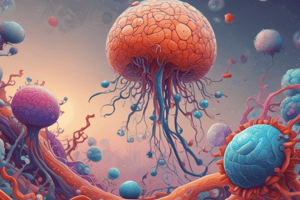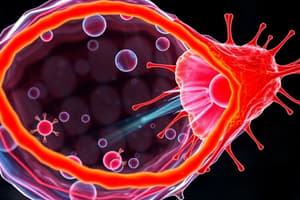Podcast
Questions and Answers
What is the primary function of the mitochondria in a cell?
What is the primary function of the mitochondria in a cell?
- Energy production (correct)
- Protein synthesis
- Cell division
- DNA replication
According to Mendelian genetics, what determines the physical expression of an individual's genotype?
According to Mendelian genetics, what determines the physical expression of an individual's genotype?
- Phenotype (correct)
- Traits
- Genotype
- Environment
In an ecosystem, what is the term for the specific role of a species?
In an ecosystem, what is the term for the specific role of a species?
- Niche (correct)
- Population
- Community
- Habitat
What is the process by which cells convert light energy into chemical energy?
What is the process by which cells convert light energy into chemical energy?
What is the term for the random change in gene frequency in a population?
What is the term for the random change in gene frequency in a population?
What is the term for the study of the geographic distribution of species?
What is the term for the study of the geographic distribution of species?
What type of microorganism lacks a nucleus?
What type of microorganism lacks a nucleus?
What is the process by which microorganisms break down organic matter?
What is the process by which microorganisms break down organic matter?
What is the primary function of photosynthesis?
What is the primary function of photosynthesis?
In which part of the chloroplast do the dark reactions take place?
In which part of the chloroplast do the dark reactions take place?
What is the purpose of the centromere in a chromosome?
What is the purpose of the centromere in a chromosome?
What is the longest phase of the cell cycle?
What is the longest phase of the cell cycle?
What are the three stages of interphase?
What are the three stages of interphase?
What is the purpose of the light reactions in photosynthesis?
What is the purpose of the light reactions in photosynthesis?
What is the purpose of cytokinesis?
What is the purpose of cytokinesis?
What are the four stages of mitosis?
What are the four stages of mitosis?
What happens to chromatin in prophase?
What happens to chromatin in prophase?
What is the result of cytokinesis in animal cells?
What is the result of cytokinesis in animal cells?
What is the term for a sex cell, such as a sperm or egg?
What is the term for a sex cell, such as a sperm or egg?
What happens in metaphase of meiosis?
What happens in metaphase of meiosis?
What is the result of meiosis?
What is the result of meiosis?
What happens to the nuclear membrane in prophase?
What happens to the nuclear membrane in prophase?
What is the term for a cell with 2 full sets of chromosomes?
What is the term for a cell with 2 full sets of chromosomes?
What happens to chromosomes in anaphase of meiosis?
What happens to chromosomes in anaphase of meiosis?
Flashcards are hidden until you start studying
Study Notes
Cell Biology
- Cell Structure:
- Plasma membrane: semi-permeable membrane separating cell from environment
- Cytoplasm: jelly-like substance inside cell membrane
- Nucleus: contains genetic material (DNA)
- Mitochondria: organelles responsible for energy production
- Endoplasmic reticulum: organelle involved in protein synthesis and transport
- Cellular Processes:
- Photosynthesis: process by which cells convert light energy into chemical energy
- Cellular respiration: process by which cells generate energy from glucose
- Cell division: process of cell growth and reproduction
- Protein synthesis: process by which cells create proteins
Genetics
- Mendelian Genetics:
- Laws of inheritance: segregation, independent assortment, and dominance
- Genotype: genetic makeup of an individual
- Phenotype: physical expression of genotype
- Traits: characteristics determined by genes
- DNA and Genes:
- DNA structure: double helix with sugar-phosphate backbone and nitrogenous bases
- Gene expression: process by which genetic information is converted into proteins
- Mutations: changes in DNA sequence
- Genetic variation: differences in genetic information between individuals
Ecology
- Ecosystems:
- Community: group of interacting species
- Population: group of individuals of the same species
- Habitat: environment in which a species lives
- Niche: specific role of a species in an ecosystem
- Energy Flow:
- Producers: organisms that convert sunlight into energy
- Consumers: organisms that obtain energy by consuming other organisms
- Decomposers: organisms that break down organic matter
- Food chains: series of organisms that eat other organisms
- Food webs: networks of interconnected food chains
Evolution
- Mechanisms of Evolution:
- Natural selection: process by which beneficial traits become more common
- Genetic drift: random change in gene frequency
- Mutation: change in DNA sequence
- Gene flow: movement of genes between populations
- Evidence for Evolution:
- Fossil record: chronological record of ancient life forms
- Comparative anatomy: study of structural similarities between species
- Molecular biology: study of DNA and protein similarities between species
- Biogeography: study of geographic distribution of species
Microbiology
- Types of Microorganisms:
- Bacteria: prokaryotic cells lacking a nucleus
- Viruses: non-cellular infectious agents
- Fungi: eukaryotic cells with cell walls
- Protists: eukaryotic cells that don't fit into other categories
- Microbial Processes:
- Fermentation: process by which microorganisms convert glucose into energy
- Decomposition: process by which microorganisms break down organic matter
- Pathogenesis: process by which microorganisms cause disease
- Symbiosis: close relationships between microorganisms and other organisms
Cell Biology
- Cell Structure:
- Plasma membrane is semi-permeable, controlling what enters and leaves the cell
- Cytoplasm is a jelly-like substance inside the cell membrane, where metabolic reactions occur
- Nucleus contains genetic material (DNA) and is surrounded by a double membrane
- Mitochondria are organelles responsible for generating energy for the cell through cellular respiration
- Endoplasmic reticulum is involved in protein synthesis, transport, and storage
Genetics
- Mendelian Genetics:
- Laws of inheritance dictate how traits are passed down from generation to generation
- Genotype is the genetic makeup of an individual, consisting of alleles and genes
- Phenotype is the physical expression of an individual's genotype
- Traits are characteristics determined by genes, such as eye color or height
Ecology
- Ecosystems:
- Communities consist of interacting species that depend on each other
- Populations are groups of individuals of the same species that live in a specific area
- Habitats are environments in which a species lives, including biotic and abiotic factors
- Niches are specific roles of a species in an ecosystem, including its diet, habitat, and behavior
Evolution
- Mechanisms of Evolution:
- Natural selection favors individuals with beneficial traits, leading to adaptation
- Genetic drift is a random change in gene frequency that can lead to evolution
- Mutations are changes in DNA sequence that can result in new traits
- Gene flow is the movement of genes between populations, leading to genetic variation
Microbiology
- Types of Microorganisms:
- Bacteria are prokaryotic cells lacking a nucleus, with a range of metabolic capabilities
- Viruses are non-cellular infectious agents that replicate inside host cells
- Fungi are eukaryotic cells with cell walls, including mushrooms, molds, and yeasts
- Protists are eukaryotic cells that don't fit into other categories, including protozoa and algae
Photosynthesis
- Photosynthesis is the conversion of light energy into chemical energy that takes place in the chloroplasts of plants and algae.
- It involves two stages: light reactions and dark reactions.
- The equation for photosynthesis is: CO2 + H2O → C6H12O6 + O2.
- Light reactions take place in the thylakoid and generate ATP and NADPH, producing oxygen gas.
- Dark reactions occur in the stroma and use ATP and NADPH to generate glucose from carbon dioxide.
Cellular Reproduction
- Interphase is the longest phase of the cell cycle, where the cell grows, replicates its DNA, and prepares for cell division.
- Interphase consists of three stages: G1 (cell growth), S (DNA replication), and G2 (cell growth and organelle replication).
- Mitosis is the nucleus division process, consisting of four stages: prophase, metaphase, anaphase, and telophase.
- Prophase involves chromatin condensing into chromatids, nuclear membrane dissolution, centriole movement, and spindle fiber formation.
- Metaphase involves spindle fibers attaching to centromeres, and chromosomes lining up in the middle of the cell.
- Anaphase involves sister chromatids being pulled apart to opposite poles by spindle fibers.
- Telophase involves chromosomes uncoiling, new nuclear membranes forming, and spindle fibers breaking down.
- Cytokinesis is cell division, resulting in two new, genetically identical cells that are smaller than the parent cell.
- In animal cells, the cell membrane pinches, dividing the cell, while in plant cells, a new cell wall is formed between the two nuclei.
Cellular Reproduction (continued)
- A chromosome is made up of tightly wound chromatin.
- Chromatin is a long, thin piece of DNA made up of hundreds of genes linked together.
- The centromere is the structure that holds together sister chromatids in a double chromosome.
Meiosis
- Meiosis is a cell division process that creates gametes (sex cells).
- Gametes are haploid cells used for the creation of new organisms.
- Somatic cells are diploid body cells that make up the body of most organisms.
- Meiosis involves two successive cell divisions, resulting in four haploid cells that are genetically unique.
- The stages of meiosis are: prophase I, metaphase I, anaphase I, telophase I, cytokinesis I, prophase II, metaphase II, anaphase II, and telophase II.
Studying That Suits You
Use AI to generate personalized quizzes and flashcards to suit your learning preferences.





